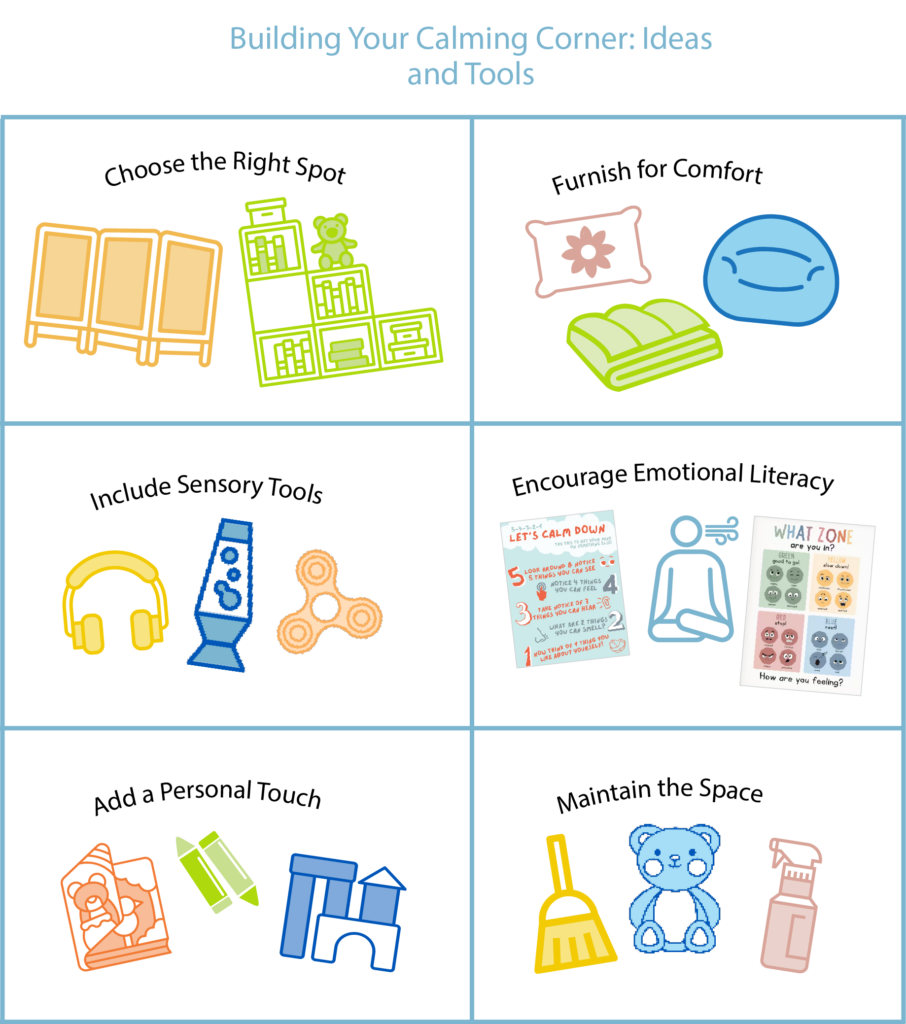In the bustling world of education, where students and teachers are constantly navigating through a whirlwind of learning activities, introducing a calming corner can be an effective solution for many student needs. As reported in Starr’s Resilient Schools Project whitepaper, this is paramount to learning. While trying to individualize the instruction and social emotional supports for every student, the universal approach to creating a safe space for all students to learn is easily overlooked, but is truly the essential component of a resilience focused classroom.
The Importance of Calming Corners
The modern classroom is a dynamic space filled with diverse personalities, learning styles, and energy levels. While excitement and engagement are integral to the learning process, moments of stress, anxiety, or overstimulation can also arise; having a dedicated space where students an retreat to find peace and regain their calmness is essential. This is where ‘Calming Corners’ come into play, not just as a physical space but as a transformative approach to classroom management and student well-being. ‘Calming Corners’ serve as dedicated spaces where students can take a moment away from the day’s demands, offering a retreat to regain composure and recenter their thoughts and emotions.
The Benefits of Calming Corners
Children process a vast amount of sensory information daily. For some, this can be overwhelming, leading to sensory overload and emotional outbursts. Calming Corners provides a sensory-friendly area that helps students filter out the chaos and focus on regaining their emotional balance. The sensory benefits are countless but include:
- Visual Calm: Soft lighting and muted colors can reduce visual stimulation.
- Auditory Relief: Quiet spaces or the use of headphones can dampen the overwhelming noise of a busy classroom.
- Tactile Engagement: Access to stress balls or soft textures can offer comfort and grounding.
- Mindfulness Activities: ‘Time-in’ time is a great opportunity for students to do some breathing or movement to return to the center.
- Proprioceptive Input: Cozy furniture or weighted blankets can provide pressure that is calming to many children.
Designing an Effective Calming Corner
Creating the perfect calming corner for your classroom doesn’t require a large budget or an expansive space. One of the best starting points to planning out a Calming Corner for your students is to include them in the process! Consider adding questions about what helps them feel peaceful, what type of objects help them focus, what colors make them feel calm, etc., during your next Circle Meeting. This involvement fosters a sense of ownership and ensures that the space resonates with the unique needs of the class. Here are some additional ideas and tools to help get you started:
- Selecting the Right Location: Choose a quiet, low-traffic area within the classroom. Ideally, the calming corner should be easily accessible but not in the midst of the main learning space.
- Creating a Cozy & Private Atmosphere: Use soft cushions, blankets of different weights and texture, and rugs to make the space inviting. Consider incorporating elements of nature, such as plants or nature-themed artwork, to evoke a sense of tranquility. Using bookshelves or room dividers is helpful to provide a sense of seclusion without complete isolation.

- Incorporating Sensory Tools – Provide a variety of sensory tools that support the students’ sensory systems.
- Visual: lava lamps, liquid timers, or calming jars
- Tactile: such as stress balls, fidget spinners, playdough or textured items.
- Auditory: headphones with calming music or nature sounds or noise canceling head phones
- Olfactory: a diffuser with calming scents such as lavender, peppermint candies to smell or eat, essential oil-infused rice bins or pillows
- These tools can engage different senses and help students channel excess energy or tension.
- Encourage Emotional Literacy – Introduce mindfulness activities, such as guided breathing exercises, calming music, or feelings charts. These visuals help children to identify and articulate their emotions while also providing them with step-by-step guides of how to practice these new skills. All of these resources can aid in relaxation and promote mindfulness.
- Personalization and Student Involvement – Incorporate art supplies to encourage expression through drawing or coloring, offering books about feelings can offer both comfort and learning.
- Maintain the Space – Keeping the area tidy and inviting on a regular basis will ensure it stays organized, warm, and inviting. Regularly rotating out the tools and resources will help to maintain the student’s interest.
Calming Corners are more than just a space; they are a testament to the evolving understanding of children’s emotional needs in an educational setting. In the ever-evolving education landscape, incorporating calming corners represents a thoughtful and proactive approach to student well-being. By acknowledging the diverse emotional needs of students and providing them with a dedicated space to navigate their feelings, educators can create a more holistic and supportive learning environment. As the saying goes, stressed brains can’t learn, and in the calm corners of our classrooms, students can find the balance needed to thrive academically and emotionally.


